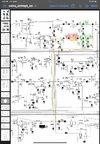OK I picked up a scope and started looking at SO42P, I was seeing 35.8MHz on pins 11&13 0volts in both RX and TX and nothing on Pins 7&8 but did see .54vdc on both RX & TX. I did trace the voltage issue back to IC4 MB3756 luckily had a spare chassis from from long, long time ago so I pulled from the old and installed.This is where a 'scope pays for itself to anyone who does this a lot.
Finding a DC-voltage fault is great, since this will usually cause loss of signal, whether in the receiver or transmitter.
But if the fault is in a part that doesn't disrupt any normal DC voltages, it becomes necessary to follow the signal that's being lost. In this case the transmit signal.
Any time there is no transmit signal, even a weak one you can 'sniff' with a spare radio, peoples' eyes will focus on IC5, the "S042P" transmit mixer chip. This is where the 7.8 MHz carrier (or sideband) gets mixed with the 35 MHz PLL's vco. The 27 MHz signal originates in this part.
And they almost never fail. Really sounds as if one of the two inputs to this chip has gone missing.
But which one? This is much more common in my experience. IC5 failure is a once-every-few-hundred radios kind of fault, if even that often.
DC-voltage measurements will lead you to an "easy" fault. But this one is sounding less easy every time a new DC voltage gets checked, and reads like it should.
This will be true when the driver and final have a drive signal, and pull normal current from the AM modulator circuit. But when there is no carrier drive, the final and driver don't draw very much collector current. R193 will drive up the voltage reading on those two test points when AM carrier drive is lost. The reading he saw makes sense, considering R193.
73
Now on SO42P I’m getting the following:
PIN 13 & 11
0.0 Vdc RX
1.3 Vdc TX
35.825 MHz
PIN 7 & 8
.54 Vdc RX
2.9 Vdc TX
no frequencies seen
PIN 2, 3 & 5
.54 Vdc RX
8.0 Vdc TX
Also I see the Modulation meter swing in AM but not in USB or LSB with no watts out. I can now hear modulation clear using a second radio in all Modes.

